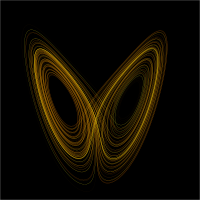
Photo from wikipedia
Collective chaos has been intensively investigated in globally coupled map and oscillators in which the single unit is capable of producing chaos. In this work, we study collective chaos in… Click to show full abstract
Collective chaos has been intensively investigated in globally coupled map and oscillators in which the single unit is capable of producing chaos. In this work, we study collective chaos in globally coupled phase oscillators. We consider a model with a trimodal natural frequency distribution. We find that increasing coupling strength leads to series of bifurcations such as Hopf bifurcation, saddle–node bifurcation, and period-doubling bifurcation. We observe the collective chaotic partial synchronous state, which is developed from quasiperiodic partial synchronous ones through a cascade of period-doubling bifurcations. We also explore the impacts of model parameters on the conditions producing collective chaos.
Journal Title: Nonlinear Dynamics
Year Published: 2017
Link to full text (if available)
Share on Social Media: Sign Up to like & get
recommendations!